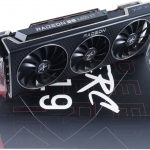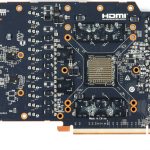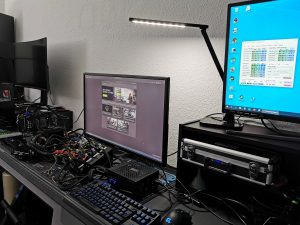After the already extensively tested reference cards of AMD’s RX 6000 series, the XFX RX 6800 XT Merc 319 16 GB has also found its way to my lab as a board partner card. The continued unavailability of all of these cards to the masses is all the more annoying because these products are really good and competitive graphics cards that deserved to make the masses of willing buyers happy as well. And so it is to be hoped that the situation will soon improve again. But first things first…
With the (Attention! Officially mandated name according to AMD’s nomenclature) “XFX Merc 319 AMD Radeon™ RX 6800 XT Gaming Graphics Card with 16GB GDDR6, AMD RDNA™ 2”, which I’ll call XFX RX 6800 XT Merc 319 16GB again in the article for simplicity’s sake as otherwise the charts and legends would explode, here’s a particularly heavy and flashy RDNA2 specimen that you have to listen twice to hear.
This graphics card, like all RX 6000 models, comes with the new video codec AV1, they also support DirectX 12 Ultimate for the first time and thus also DirectX Raytracing (DXR). With AMD FidelityFX, they also offer a feature that should also give developers more leeway in choosing effects. Also included is Variable Rate Shading (VRS), which can save immense amounts of processing power by smartly reducing the display quality of areas of the image that are not in the player’s eye anyway. So much for the feature set of all new Radeon cards.
With an MSRP of around 800 USD (Euro prices are still missing), it’s not that far above the MSRP of the reference cards, as some other competitors have announced, but it’s not particularly cheap either. However, the scarcity of the products is of course also reflected in the price, because where street prices used to be regarded as a balm for the shopper’s soul, one now has to be downright afraid of them.
Optics and haptics
The XFX RX 6800 XT Merc 319 16 GB weighs 1787 grams and is thus significantly heavier than the reference card! It is also longer with its full 34 cm, stately 12.5 cm high (12 cm installation height from PEG) and in addition 5.6 cm thick (2.7 slot design), whereby a backplate and the PCB with a total of five additional millimeters are added. The body is made of haptically very advantageous light metal, the XFX lettering and the Radeon designation on the top are LED illuminated.
The massive bulwark including illumination is powered by two standard 8-pin sockets, so everything is as known and used. We also see here the vertical orientation of the cooling fins and the board reinforcement in the form of a surrounding frame.
The slot bracket is closed, carries 1x HDMI 2.1 and two DP connectors. In addition, there is the USB Type C jack. More about the construction, the cooler and the assembly on the next page in the teardown.
Technology and Dual BIOS
With the 72 compute units (CU), the XFX RX 6800 XT Merc 319 16 GB has a total of 4608 shaders. While the base clock is specified with 2090 MHz, the boost clock is 2340 MHz. Card relies on 16 GB GDDR6 with 16 Gbps, which is made up of 8 modules of 2 GB each. This includes the 256-bit memory interface and the 128MB Infinity Cache, which is supposed to solve the bandwidth problem. The card has a switchable dual BIOS, but I couldn’t find any differences, not even when reading the BIOS information.
Raytracing / DXR
At the latest since the presentation of the new Radeon cards it is clear that AMD will also support ray tracing. Here one goes a way clearly deviating to NVIDIA and implements a so-called “Ray Accelerator” per Compute Unit (CU). Since the Radeon RX 6800 has a total of 72 CUs, this also results in 72 such accelerators for the Radeon RX 6800XT, while the smaller Radeon RX 6800 still has 60. A GeForce RTX 3080 comes with 68 RT cores, which is nominally less for now. When comparing the smaller cards, the score is 62 for the RX 6800 and 46 for the GeForce RTX 3070. However, RT cores are organized differently and we will have to wait and see what quantity can do against specialization here. So in the end it’s an apples and oranges comparison for now.
But what has AMD come up with here? Each of these accelerators is first capable of simultaneously computing up to 4 beam/box intersections or a single beam/triangle intersection per cycle. This way, the intersection points of the rays with the scene geometry are calculated (analogous to the Bounding Volume Hierarchy), first pre-sorted and then this information is returned to the shaders for further processing within the scene or the final shading result is output. NVIDIA’s RT cores, however, seem to have a much more complex approach to this, as I explained in detail during the Turing launch. What counts is the result alone, and that’s exactly what we have suitable benchmarks for.
Smart Access Memory (SAM)
AMD already showed SAM, i.e. Smart Access Memory, at the presentation of the new Radeon cards – a feature I enabled today in addition to the normal benchmarks, which also allows a direct comparison. But actually SAM is not Neuers, just verbally more nicely packaged. This is nothing else than the clever handling of the Base Address Register (BAR) and exactly this support must be activated in the substructure. With modern AMD graphics hardware, resizable PCI bars (see also PCI SIG from 4/24/2008) have played an important role for quite some time, since the actual PCI BARs are normally only limited to 256 MB, while with the new Radeon graphics cards you can now find up to 16 GB VRAM.
The result is that only a fraction of the VRAM is directly accessible to the CPU, which without SAM requires a whole series of workarounds in the so-called driver stack. Of course, this always costs performance and should therefore be avoided. So that’s where AMD comes in with SAM. This is not new, but it must be implemented cleanly in the UEFI and later also activated. This only works if the system is running in UEFI mode and CSM/Legacy are disabled.
CSM stands for the Compatibility Support Module. The Compatibility Support Module is exclusive to UEFI and ensures that older hardware and software will work with UEFI. The CSM is always helpful when not all hardware components are compatible with UEFI. Some older operating systems and the 32-bit versions of Windows also do not install on UEFI hardware. However, it is precisely this compatibility setting that often prevents the clean Windows variant required for the new AMD components from being installed.
Benchmarks, test system and evaluation software
For the benchmarks, I chose the same 10 games, analogous to the launch article, weighting between old and new, and AMD- or NVIDIA-specific. Since everything is very similar to the launch article of the Radeon cards, this time there is only a cumulative summary of all games with a detailed explanation for each resolution. The power consumption is also given in great detail, as you are used to.
The benchmark system is new and I am now also using PCIe 4.0, matching X570 motherboards in the form of the MSI MEG X570 Godlike and a selected Ryzen 9 5950X that has been water cooled overclocked (PBO + 500 MHz). Add to that the matching DDR4 4000 RAM from Corsair, as well as several fast NVMe SSDs. For direct logging during all games and applications, I use my own measurement station with shunts and riser card, as well as NVIDIA’s PCAT in games, which adds to the convenience immensely.
The measurement of the detailed power consumption and other, more profound things takes place here in the special laboratory on a redundant and in detail identical test system then double-tracked by means of high-resolution oscillograph technology…
…and the self-created MCU-based measurement setup for motherboards and graphics cards (pictures below), where at the end in the air-conditioned room also the thermographic infrared images are created with a high-resolution industrial camera. The audio measurements are done outside in my Chamber (room within a room).
I have also summarized the individual components of the test system in a table:
| Test System and Equipment |
|
|---|---|
| Hardware: |
AMD Ryzen 9 5950X OC MSI MEG X570 Godlike 2x 16 GB Corsair DDR4 4000 Vengeance RGB Pro 1x 2 TByte Aorus (NVMe System SSD, PCIe Gen. 4) 1x 2 TB Corsair MP400 (Data) 1x Seagate FastSSD Portable USB-C Be Quiet! Dark Power Pro 12 1200 Watt |
| Cooling: |
Alphacool Eisblock XPX Pro Alphacool Eiswolf (modified) Thermal Grizzly Kryonaut |
| Case: |
Raijintek Paean |
| Monitor: | BenQ PD3220U |
| Power Consumption: |
Oscilloscope-based system: Non-contact direct current measurement on PCIe slot (riser card) Non-contact direct current measurement at the external PCIe power supply Direct voltage measurement at the respective connectors and at the power supply unit 2x Rohde & Schwarz HMO 3054, 500 MHz multichannel oscilloscope with memory function 4x Rohde & Schwarz HZO50, current clamp adapter (1 mA to 30 A, 100 KHz, DC) 4x Rohde & Schwarz HZ355, probe (10:1, 500 MHz) 1x Rohde & Schwarz HMC 8012, HiRes digital multimeter with memory function MCU-based shunt measuring (own build, Powenetics software) NVIDIA PCAT and FrameView 1.1 |
| Thermal Imager: |
1x Optris PI640 + 2x Xi400 Thermal Imagers Pix Connect Software Type K Class 1 thermal sensors (up to 4 channels) |
| Acoustics: |
NTI Audio M2211 (with calibration file) Steinberg UR12 (with phantom power for the microphones) Creative X7, Smaart v.7 Own anechoic chamber, 3.5 x 1.8 x 2.2 m (LxTxH) Axial measurements, perpendicular to the centre of the sound source(s), measuring distance 50 cm Noise emission in dBA (slow) as RTA measurement Frequency spectrum as graphic |
| OS: | Windows 10 Pro (all updates, current certified or press drivers) |
- 1 - Introduction and Technical Details
- 2 - Teardown: PCB and Cooler
- 3 - Gaming Performance
- 4 - Power Consumtion in Gaming and Efficiency
- 5 - Power Consumption in Detail, Voltages and Standards
- 6 - Transients and PSU Recommendation
- 7 - Clock Rate and Temperatures
- 8 - Fan Speed and Noise
- 9 - Summary and Conclusion


























































Kommentieren